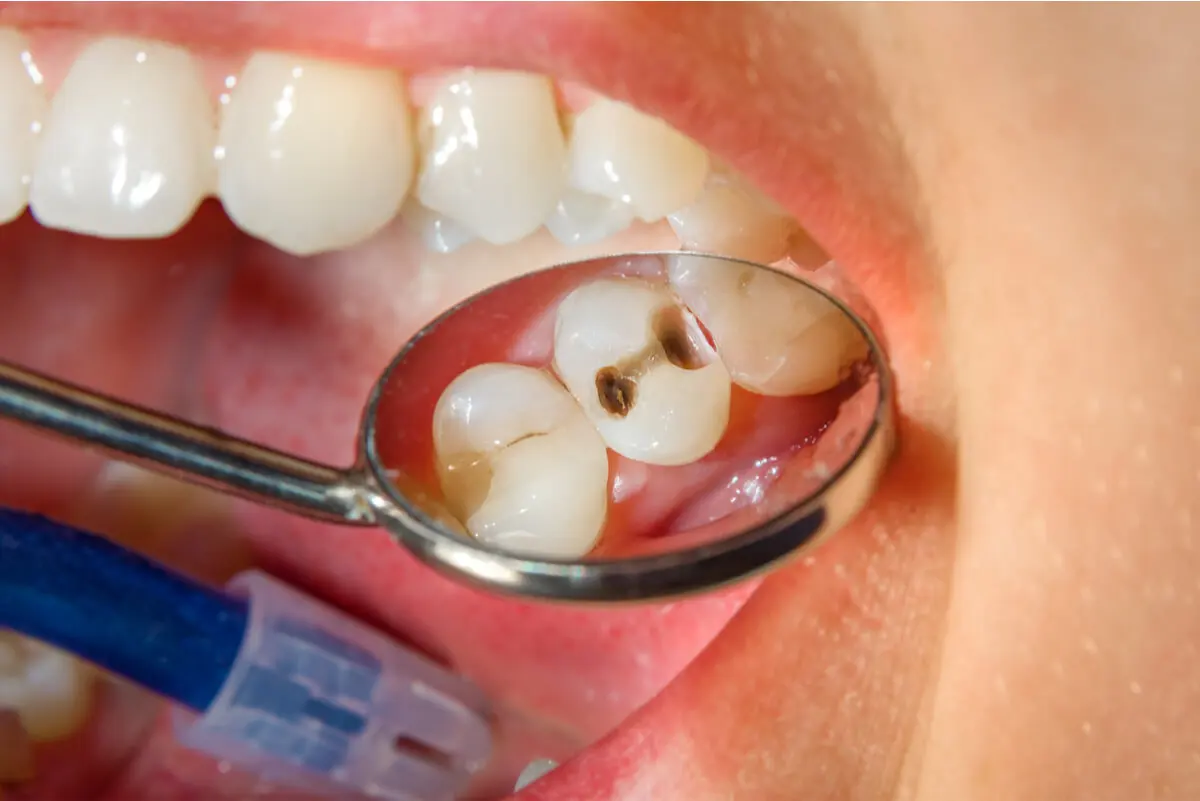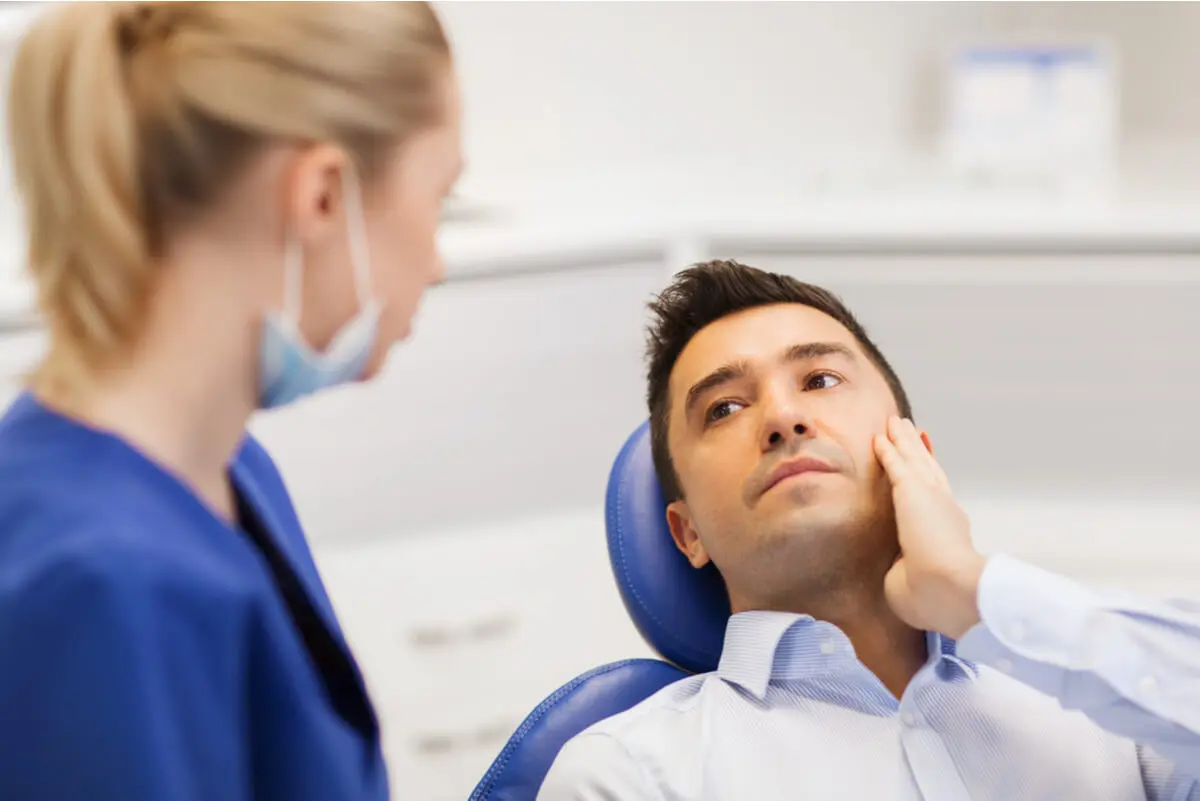Pulpitis: Symptoms, Causes, Types, and Treatment


Reviewed and approved by the doctor Leonardo Biolatto
When certain stimuli, such as intense cold or heat, it’s normal for the teeth to hurt a little. However, the pain should go away when the stimulation stops. If the pain doesn’t go away, then it’s probably pulpitis. In this article, we’re going to tell you more about the types, symptoms, causes, and treatment of this dental condition.
What is pulpitis?
Pulpitis is nothing more than the inflammation of the dental pulp of one or more teeth as a result of caries, trauma, or some other cause. But what is dental pulp? Well, it’s a lax connective tissue surrounded by a hard substance called dentin.
The dental pulp is responsible for generating various substances for the proper maintenance of the teeth. However, this tissue is characterized by an inflammatory response to any type of injury, thus generating pulpitis.
This condition is the second most frequent cause of dental emergencies, with a 40% incidence rate. In addition, it has various modes of presentation, which depend on its evolution over time.
Reversible pulpitis
In this case, the inflammatory condition ranges from mild to moderate. In other words, the affected tooth will produce pain in response to various stimuli. However, when the pain ceases, the pulp will be able to return to its original state.
Nevertheless, despite being the initial phase of the disease, the pain can become unbearable due to the great innervation and vascularization of the pulp. But, as its name says, this state is reversible, and it will only be necessary to attack the cause of the problem to reach a solution.
Irreversible pulpitis
When we talk about irreversible pulpitis, we refer to a more advanced stage of the disease. In this sense, the inflammation inside the cavity has already compromised the blood circulation of the pulp, which will generate necrosis and death of the pulp.
It’s important to emphasize that when the dental pulp reaches this point, it’s impossible to recover it. Therefore, its treatment is a little more invasive and extensive.

We think you may be interested in reading this, too: 9 Natural and Effective Tips for Taking Care of Your Teeth
Hyperplastic pulpitis
Hyperplastic pulpitis is the most unusual form of all and, at the same time, the one that requires more time to appear. This is a form of chronic inflammation of the pulp resulting from long-term cavity exposure.
This type of inflammation is characterized by the proliferation of granulomatous tissue within the cavity. In this sense, cells that are not characteristic of the teeth may appear, such as the non-keratinized stratified flat tissue that constitutes the gums.
Symptoms of pulpitis
The main symptom that characterizes this condition is dental pain in response to certain stimuli. It’s important to note that the pain is usually poorly located and is not limited to the affected tooth. Therefore, patients might notice the pain in a completely healthy area.
However, this can vary greatly according to the type of pulpitis present. Thus, when we are dealing with a reversible form, the pain will be evident in response to a specific stimulus such as cold or heat. Then, it will disappear after a few seconds.
On the other hand, in the presence of irreversible pulpitis, the pain will remain for a few minutes, even after the stimulus has ceased. In addition, on certain occasions, patients may report spontaneous pain – that is, pain that appears without any apparent cause.
After some time has elapsed with irreversible pulpitis, the dental pulp will be necrotic. This will cause the loss of dental sensitivity to stimuli. Discomfort to pressure and during chewing will then appear.
Finally, hyperplastic pulpitis is asymptomatic due to its chronic condition. In this case, the affected tissue has already been covered with a new one, which gives it some protection. In spite of this, sufferers may experience some discomfort during chewing.
The causes of pulpitis
Generally speaking, the main cause of pulpitis is dental cavities, as these manage to penetrate the dentin and can affect the pulp. In addition, it can also be caused by blows, erosion, periodontitis, and even poorly performed dental procedures.
However, due to some small variations, it’s more convenient to study them separately, according to each type. In this regard, the most frequent causes of reversible pulpitis are the following:
- Dental cavities that do not affect the nerve.
- Erosion in the teeth that reaches the dentin.
- Exposed dentin following a dental fracture.
- Bacterial infections that affect the pulp.
- Severe cases of bruxism.
On the other hand, the causes of irreversible pulpitis are a little more specific and severe. Among them, we can find the following:
- Very advanced dental cavities that affect the dental pulp.
- Orthodontic treatments,when performed with excessive force in a way that decreases blood flow.
- When more tissue is removed than expected during a deep filling, and the pulp is exposed.
Finally, hyperplastic pulpitis has only one probable cause. It appears in teeth with severe cavites in which the dental pulp has been exposed for a prolonged period of time.

Like this article? You may also like to read: Seven Home Remedies for Removing Plaque From Your Teeth
Pulpitis treatment
Regardless of the type of pulpitis a person presents, the initial treatment will consist of the use of antibiotics and anti-inflammatory drugs. This is in order to reduce inflammation and fight infection, if any.
Once the pharmacological treatment is finished, the condition itself will be treated. In the case of reversible pulpitis, it should be taken into account that these are largely caused by caries. Therefore, the treatment will be based on its removal, either with a dental filling or endodontics.
On the other hand, when it’s an irreversible or hyperplastic form of pulpitis, the treatment will be a little more invasive. In these cases, a pulpotomy or pulpectomy will be performed – that is, the partial or total extraction of the dental pulp.
What to keep in mind regarding pulpitis?
Pulpitis in itself doesn’t represent a dangerous condition. That is to say, it won’t cause a life-threatening situation in the short term. However, the pain can be quite annoying and does constitute a dental emergency.
The best thing to do to prevent this condition is to have correct oral hygiene, especially in the case of the youngest members of the family. This is because they’re the most prone to suffering from cavities, which is the main cause of this dental problem.
All cited sources were thoroughly reviewed by our team to ensure their quality, reliability, currency, and validity. The bibliography of this article was considered reliable and of academic or scientific accuracy.
- Pérez Ruiz A, Roseñada Cepero R, Grau León I, González Ramos R. Interpretación fisiopatológica de los diferentes estadios de una pulpitis. Rev Cubana Estomatol. 2005;42(2).
- Morales A, Vareliano G. Tratamientos conservadores de la vitalidad pulpar y tratamiento endodóntico en una sesión [Universitario]. Universidad Nacional Mayor de San Marcos; 2010.
- Perero Perero O. Manejo de la pulpitis irreversible. Caso clínico. [Universitario]. Universidad de Guayaquil; 2016.
- López Castellanos L, Toledo Reyes L, Machado Rodríguez R. Caracterización de las pulpitis agudas. Medicentro Electrónica. 2017; 21( 3 ): 231-233.
- Pita Laborí L, Matos Cantillo D, Pita Laborí K. Pulpitis crónica hiperplásica. Presentación de un caso. Revista Información Científica. 2018;97( 4 ): 842-850.
- Berger, César Olivares, et al. “Agudizaciones endodóncicas: incidencia y su relación con el diagnóstico pre-operatorio.” Revista KIRU 13.1 (2016).
- Alcaide Espinosa, J., Baonza Carqués, and A. Martínez Muñoz. “Revisión clínico-patológica de la pulpitis crónica hiperplásica: Definición, etiología y tratamiento.”
- Hahn, Chin-Lo, and Frederick R. Liewehr. “Relationships between caries bacteria, host responses, and clinical signs and symptoms of pulpitis.” Journal of endodontics 33.3 (2007): 213-219.
- Antoniak, M., et al. “Selected aspects of treatment of irreversible pulpitis.” Progress in Health Sciences 7.2 (2017): 111-116.
- Suneelkumar, Chinni, Anirudhan Subha, and Dorasani Gogala. “Effect of preoperative corticosteroids in patients with symptomatic pulpitis on postoperative pain after single-visit root canal treatment: a systematic review and meta-analysis.” Journal of endodontics 44.9 (2018): 1347-1354.
This text is provided for informational purposes only and does not replace consultation with a professional. If in doubt, consult your specialist.








